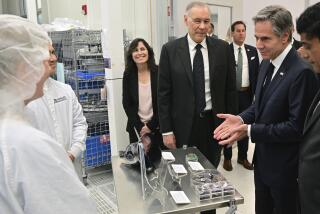Stanford Selected for Antimatter Research Lab : Science: The $237-million project will get down to the basics of why matter exists. The award is seen as a major boost for California’s technological community.
- Share via
A coveted antimatter research project awarded Monday to the Stanford Linear Accelerator Center aims to answer one of the most fundamental questions about the universe:
Why does matter exist?
Scientists will analyze millions of special subatomic particles called B mesons to compare the behavior of matter and antimatter. They hope they can understand how a universe of physical stuff--stars, planets and people--emerged from the primal fireball of the Big Bang. Theoretically, matter and antimatter should have been produced in equal measure and should have destroyed each other.
President Clinton announced the selection of the Stanford center over Cornell University for the $237-million project during a visit to San Francisco.
The project--a high-energy physics accelerator called the Asymmetric B-Factory--will be a collaboration between the Stanford accelerator group and two major University of California laboratories: Lawrence Berkeley Laboratory and Lawrence Livermore National Laboratory.
Officials at the Stanford center estimate that the B factory itself will cost $177 million in federal money over the next five years, with an additional $60 million to be spent on a particle detector.
“This unique facility will attract scientists from across the nation and around the globe to do leading-edge research on the difference between matter and antimatter,” said Burton Richter, director of the Stanford center.
The award is a significant boost for California’s research community. Without the project, center officials said they would have had to lay off as many as 300 of the laboratory’s 1,400 employees next year.
But final approval of the first $36 million for the project awaits action by a joint congressional conference committee later this week. Only the House of Representatives has approved funding thus far.
“We have one more small hurdle to cross,” Michael Riordan, assistant lab director, said. “We are cautiously optimistic.” If the funding clears the conference committee, construction could be begin later this fall.
Officials at Cornell, generally considered the leader in B meson research, reacted with disappointment and some bitterness Monday.
“We have yet to see the full statement from (Energy Secretary Hazel R.) O’Leary,” Cornell President Frank H.T. Rhodes said. “But we will be hard pressed to understand how in these difficult fiscal times the federal government can justify awarding the project to a facility where it will cost $100 million more to accomplish the same scientific objectives than it would if built at Cornell.
“We’ve been at a disadvantage on this project since early this year, when the Administration determined to award the project without any semblance of peer review,” Rhodes said.
Stanford center officials said the project has had “very broad and very positive” peer review, including a recommendation from the federal High Energy Physics Advisory Panel.
“I have selected Stanford because the Department of Energy has a much higher margin of confidence in the ability of the Stanford proposal to meet the project’s extremely high performance requirements, as well as to meet its proposed cost and schedule,” O’Leary said.




